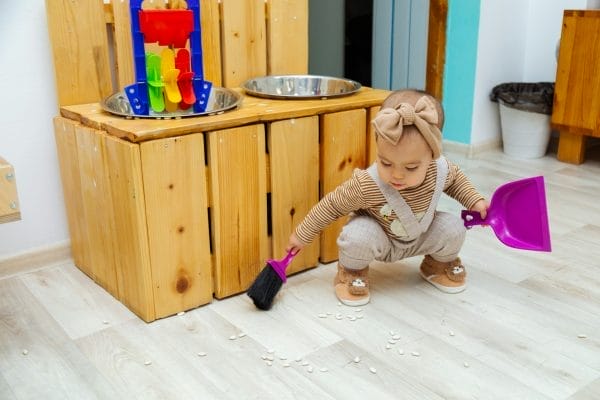Practical Life Activities: Everyday Tasks as Learning Tools
Practical life activities are simple, everyday tasks that are designed to teach children how to take care of themselves and their environment. These activities are not only fundamental in teaching kids about responsibility and autonomy but also play a crucial role in their development. They are a cornerstone of the Montessori method of education, which emphasizes hands-on learning and self-directed activity. Let’s delve into what practical life activities are and how they benefit children, especially when implemented in a Montessori setting.

What Are Practical Life Activities?
![]()
Practical life activities are tasks that are familiar to children because they see adults perform them regularly. These activities include a wide range of tasks from dressing oneself to preparing a simple snack. They are geared towards teaching children how to interact with their environment and manage everyday life skills. The beauty of these activities lies in their simplicity and their profound impact on a child’s growth.
Practical Life Activities for Montessori
![]()
In a Montessori classroom, practical life activities are carefully designed to encourage children to develop control and coordination of movement, concentration, and independence. Here’s a closer look at some of the tasks you might find in a Montessori practical life activities list:
- Pouring and spooning exercises
- Buttoning and tying laces
- Cleaning and dusting
- Plant care and gardening
- Food preparation and table setting
Each of these activities is structured to help children master the task at hand and understand the sequence of steps involved. Through repetition, children gain confidence in their abilities to perform these tasks without adult intervention.
Practical Life Activities for Toddlers
![]()
When it comes to practical life activities for toddlers, the focus is on very simple tasks that can be accomplished with their limited dexterity and concentration span. Some examples of these activities are:
- Washing hands
- Using a napkin
- Carrying a small tray
- Opening and closing containers
- Snack preparation, like peeling a banana or spreading butter on bread
These activities are not only about teaching toddlers how to perform certain tasks but also about developing their motor skills, growing their attention spans, and fostering a sense of independence.
The Benefits of Practical Life Activities
![]()
The advantages of incorporating practical life activities into a child’s daily routine are numerous. Here are just a few:
- Development of fine motor skills: Many practical life activities require the use of the hands in precise ways, such as threading beads or using utensils, which can enhance fine motor skill development.
- Enhanced concentration: As children focus on completing a task from start to finish, they learn to concentrate for longer periods of time.
- Increased independence: When children are capable of taking care of their own needs and contributing to the care of their environment, they feel more autonomous and confident.
- Sense of order: Through practical life activities, children learn to follow sequences, which helps them understand and appreciate order in their surroundings and daily lives.
- Social development: These activities often involve sharing, taking turns, and working cooperatively, which are key components in social development.
Moreover, engaging in practical life activities can also lead to the development of self-discipline as children learn to correct their own mistakes and control their impulses.
Examples and Case Studies
![]()
Let’s look at a few examples and case studies that highlight the effectiveness of practical life activities in child development:
- Case Study: A study conducted in a Montessori classroom showed a significant improvement in concentration and independence among children who regularly engaged in practical life activities compared to those who did not.
- Example: A toddler who learns to pour water from a small pitcher into a glass not only masters the skill of pouring but also learns to clean up spills, enhancing both their coordination and responsibility.
- Case Study: Research suggests that children who participate in household chores, which are a type of practical life activity, are more likely to be successful in their professional lives as adults.
These examples and studies reinforce the idea that the skills learned through practical life activities can have long-term benefits that extend well beyond childhood.
Montessori Classroom Practical Life Activities
![]()
In a Montessori classroom, practical life activities are a staple. They are typically the first activities a child is introduced to when they enter the classroom. These activities not only help children adapt to the classroom environment but also serve as a bridge between home and school. Here are some of the characteristics of Montessori classroom practical life activities:
- They are based on real-life tasks and are meaningful to the child.
- Materials are child-sized to ensure that children can use them easily and successfully.
- Activities are designed to be aesthetically pleasing and inviting to children.
- Tasks are presented in a way that children can complete them with minimal adult assistance.
- Children are encouraged to repeat the activities as often as they like, promoting mastery.
By engaging in these activities, children learn to function independently and take pride in their ability to contribute to their community, whether it’s their classroom, family, or the wider society.
Conclusion
![]()
Practical life activities are a fundamental part of early childhood education, especially within the Montessori philosophy. They provide children with opportunities to develop a wide range of skills, from fine motor abilities to social competencies. By participating in these activities, children gain a sense of independence, confidence, and responsibility that will serve them throughout their lives.
Whether in a Montessori classroom or at home, practical life activities are invaluable in helping children connect with their world in a meaningful and enriching way. The key takeaway is that by integrating these tasks into a child’s daily routine, we are not only teaching them about life’s practicalities but also setting the foundation for a lifetime of learning and personal growth.




